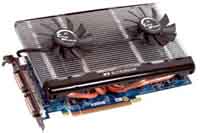 by congo » Tue Jan 13, 2004 8:33 pm
by congo » Tue Jan 13, 2004 8:33 pm
I have run GameXP on my setup. It is a radical transformation of the WinXP operating system and hardware management to tweak it for Gaming
So, when you clicked the "turbo" button or whatever, you set about a very complex and fundamental change to your OpSys.
The problem with GameXP1 is that the "Restore WinXP Default settings" button does just that..... It restores the registry of WinXP to a plain vanilla fresh install mode
of Windows with no custom setttings and perhaps even negates some of your needed hardware drivers or other important and specific software.
I would try reinstalling the AGP graphics drivers (and your video card driver) for the mainboard chipset as well as what you already did.
Now saying that, I am able to hit that "default settings" button and then make a few adjustments with my other settings and get WinXP back to normal in about 5 minutes or so. But I can see where GameXP is potentially harmful to many PC's operating systems.
I would like to have seen some fairly specific and Visible WARNING! text next to the GO! button on GameXP.
Another thing.... After using the tweak on a powerful and well setup system, I benchmarked and found NO noticeable difference in my PC's or graphics speed!
I would expect that an underpowered system would benefit however.
Did you bother to read the following document sitting right next to the GameXP1.exe program?
If you had read it, you may have understood what you were about to do to your system.
***Note***
The forum wouldn't let me submit the details of the changes GAME XP 1 makes, (that's how long and comprhensive they are) so here is a portion of the document:
*** ***
HOW IT WORKS:
When GameXP runs, you can
Disable all tweaks and return to default Windows settings.
Or press the Go to Warp speed and make games to run faster and boost overall performance of your computer.
TECHNICAL INFORMATION:
Performance Settings Changes cache settings for gaming system, increases performance on NTFS or FAT drives.
Increases performance in Windows by giving foreground applications much greater processor time than applications that are running in the background.
Optimizes registry values to speed up Windows updating Of directories, moving or copying Zip Files and boosts network logon, overall boot time.
Corrects DirectX, Direct3D and AVI Files problems.
Decreases the time that windows waits to shutdown application that aren't responding.
Configures the usage of the CPU's 2nd level cache size of the non-paged pool. It changes these settins to default recomended values.
Disables Print job logging and prevents log files from running out of space.
Corrects Athlon AGP Hang Ups problem.
... and much more.
--------------------------------------------------------------------------------
Cosmetic Settings Turns off balloon tips and tool tips in Windows applications.
Completely disables animated windows.
Makes icons in windows appear quicker.
Stops explorer from caching thumbnail pictures.
... and much more.
--------------------------------------------------------------------------------
Services XP starts a number of background services automatically, many are unessential and can be disabled or set to start manually to optimize the performance of your computer.
These services are disabled or set to start manually by Game XP:
Error report service
If a program crashes on your machine, Windows generates an error
report, which it wants to send to Microsoft.
Alerter
Notifies selected users and computers of administrative alerts. If the service is stopped, programs that use administrative alerts will not receive them. If this service is disabled, any services that explicitly depend on it will fail to start.
Application Management
Provides software installation services such as Assign, Publish, and Remove.
Automatic Updates
Enables the download and installation of critical Windows updates. If the service is disabled, the operating system can be manually updated at the Windows Update Web site.
Background Intelligent Transfer Service
Uses idle network bandwidth to transfer data.
Computer Browser
Maintains an updated list of computers on the network and supplies this list to computers designated as browsers. If this service is stopped, this list will not be updated or maintained. If this service is disabled, any services that explicitly depend on it will fail to start.
ClipBook
Enables ClipBook Viewer to store information and share it with remote computers. If the service is stopped, ClipBook Viewer will not be able to share information with remote computers. If this service is disabled, any services that explicitly depend on it will fail to start.
COM+ System Application
Manages the configuration and tracking of Component Object Model (COM)+-based components. If the service is stopped, most COM+-based components will not function properly. If this service is disabled, any services that explicitly depend on it will fail to start.
COM+ Event System
Supports System Event Notification Service (SENS), which provides automatic distribution of events to subscribing Component Object Model (COM) components. If the service is stopped, SENS will close and will not be able to provide logon and logoff notifications. If this service is disabled, any services that explicitly depend on it will fail to start.
Distributed Link Tracking Client
Maintains links between NTFS files within a computer or across computers in a network domain.
Distributed Transaction Coordinator
Coordinates transactions that span multiple resource managers, such as databases, message queues, and file systems. If this service is stopped, these transactions will not occur. If this service is disabled, any services that explicitly depend on it will fail to start.
Fast User Switching Compatibility
Provides management for applications that require assistance in a multiple user environment.
Help and Support
Enables Help and Support Center to run on this computer. If this service is stopped, Help and Support Center will be unavailable. If this service is disabled, any services that explicitly depend on it will fail to start.
IMAPI CD-Burning COM Service
Manages CD recording using Image Mastering Applications Programming Interface (IMAPI). If this service is stopped, this computer will be unable to record CDs. If this service is disabled, any services that explicitly depend on it will fail to start.
Indexing Service
Indexes contents and properties of files on local and remote computers; provides rapid access to files through flexible querying language.
Messenger
Transmits net send and Alerter service messages between clients and servers. This service is not related to Windows Messenger. If this service is stopped, Alerter messages will not be transmitted. If this service is disabled, any services that explicitly depend on it will fail to start.
MS Software Shadow Copy Provider
Manages software-based volume shadow copies taken by the Volume Shadow Copy service. If this service is stopped, software-based volume shadow copies cannot be managed. If this service is disabled, any services that explicitly depend on it will fail to start.
NetMeeting Remote Desktop Sharing
Enables an authorized user to access this computer remotely by using NetMeeting over a corporate intranet. If this service is stopped, remote desktop sharing will be unavailable. If this service is disabled, any services that explicitly depend on it will fail to start.
Network DDE
Provides network transport and security for Dynamic Data Exchange (DDE) for programs running on the same computer or on different computers. If this service is stopped, DDE transport and security will be unavailable. If this service is disabled, any services that explicitly depend on it will fail to start.
Network DDE DSDM
Manages Dynamic Data Exchange (DDE) network shares. If this service is stopped, DDE network shares will be unavailable. If this service is disabled, any services that explicitly depend on it will fail to start.
Network Connections
Manages objects in the Network and Dial-Up Connections folder, in which you can view both local area network and remote connections.
NT LM Security Support Provider
Provides security to remote procedure call (RPC) programs that use transports other than named pipes.
Performance Logs and Alerts
Collects performance data from local or remote computers based on preconfigured schedule parameters, then writes the data to a log or triggers an alert. If this service is stopped, performance information will not be collected. If this service is disabled, any services that explicitly depend on it will fail to start.
Protected Storage
Provides protected storage for sensitive data, such as private keys, to prevent access by unauthorized services, processes, or users.
Remote Desktop Help Session Manager
Manages and controls Remote Assistance. If this service is stopped, Remote Assistance will be unavailable. Before stopping this service, see the Dependencies tab of the Properties dialog box.
Remote Procedure Call (RPC) Locator
Manages the RPC name service database.
Remote Registry
Enables remote users to modify registry settings on this computer. If this service is stopped, the registry can be modified only by users on this computer. If this service is disabled, any services that explicitly depend on it will fail to start.
QoS RSVP
Provides network signaling and local traffic control setup functionality for QoS-aware programs and control applets.

Mainboard: Asus P5K-Premium, CPU=Intel E6850 @ x8x450fsb 3.6ghz, RAM: 4gb PC8500 Team Dark, Video: NV8800GT, HDD: 2x1Tb Samsung F3 RAID-0 + 1Tb F3, PSU: Antec 550 Basiq, OS: Win7x64, Display: 24&




 Mainboard: Asus P5K-Premium, CPU=Intel E6850 @ x8x450fsb 3.6ghz, RAM: 4gb PC8500 Team Dark, Video: NV8800GT, HDD: 2x1Tb Samsung F3 RAID-0 + 1Tb F3, PSU: Antec 550 Basiq, OS: Win7x64, Display: 24&
Mainboard: Asus P5K-Premium, CPU=Intel E6850 @ x8x450fsb 3.6ghz, RAM: 4gb PC8500 Team Dark, Video: NV8800GT, HDD: 2x1Tb Samsung F3 RAID-0 + 1Tb F3, PSU: Antec 550 Basiq, OS: Win7x64, Display: 24&





 Mainboard: Asus P5K-Premium, CPU=Intel E6850 @ x8x450fsb 3.6ghz, RAM: 4gb PC8500 Team Dark, Video: NV8800GT, HDD: 2x1Tb Samsung F3 RAID-0 + 1Tb F3, PSU: Antec 550 Basiq, OS: Win7x64, Display: 24&
Mainboard: Asus P5K-Premium, CPU=Intel E6850 @ x8x450fsb 3.6ghz, RAM: 4gb PC8500 Team Dark, Video: NV8800GT, HDD: 2x1Tb Samsung F3 RAID-0 + 1Tb F3, PSU: Antec 550 Basiq, OS: Win7x64, Display: 24&
